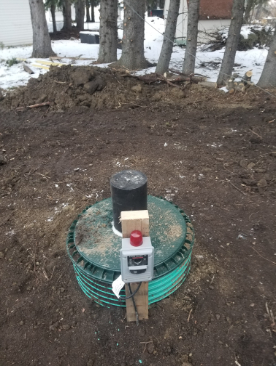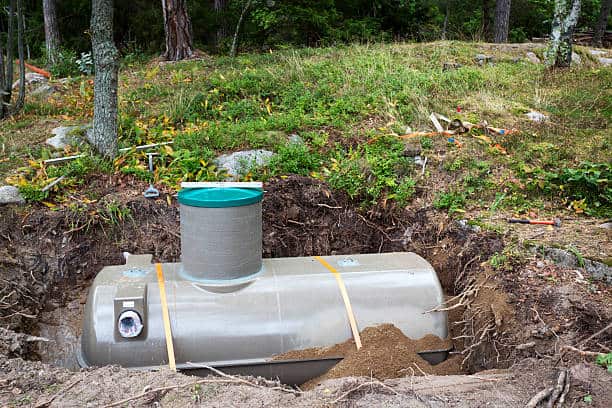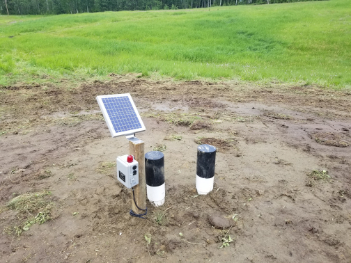
Septic System Design
KJA Septic Services Inc. offers professional septic system design done by an Alberta Onsite Wastewater Management Association certified designer to meet or exceed all provincial and municipal requirements.
The design of a septic system requires a few steps to evaluate the needs of a property owner. The process begins by the customer filling out a homeowners information sheet. This form gives us the preliminary information on your existing or planned building and land location to help with the design of your system.
Septic System Design
We will also find pre evaluation documentation online and order a Alberta One Call locator. Moving forward a site visit will be scheduled to evaluate the needs of the property owner. A meeting with the customer as well as the landscape, site limitations (streams, peripheral structures etc.) and setbacks (property lines, wells etc.) will determine a location for the system.
The next step is taking soil samples to determine load rates of effluent to the soil which in turn will determine size and style options of onsite wastewater treatment systems that can be installed.
Septic System Design (cont.)
The second part of the design process begins with selecting the type of septic system, KJA Septic Services works with our customers to come up with the most feasible system. The system will meet their needs as well as provincial and municipal requirements while properly treating effluent and standing the test of time. Lastly site and soil evaluation reports, systems plans and other filing documents can be prepared for the customer as well as the governing body to obtain permits.
Septic System Installation
KJA Septic Services will work through the design process in a timely matter and continue to work with you through the installation process to exceed your expectations. Once the installation is complete we will spend time with you to explain how the system works, the do’s and do not’s, a maintenance schedule, and some follow up literature. We will show respect to your property and work efficiently so your experience is as stress free as possible.


Types of Onsite Wastewater Management Systems
Tank And Conventional Field
Standard soil-based treatment systems use a septic tank for initial treatment. The household plumbing collects wastewater and sends it to the septic tank which acts as a separation chamber. Heavy particles separate from the wastewater and settle to the bottom to form a sludge layer. Lighter particles, mainly soap, grease and toilet tissue separate and float to the top to form a scum layer. Using a baffle device the clearest liquid from the center of the tank flows by gravity to the effluent dosing chamber. A pump or siphon in the effluent dosing chamber will deliver the effluent to the final soil treatment component, in this case the septic field.
Tank And Sand Mound
As discussed above, the household plumbing collects the wastewater and sends it to the septic tank where it is separated into the three layers, sludge, scum and wastewater.
Tank And Sand Mound (cont.)
Once the wastewater enters the effluent dosing chamber of the septic tank, the pump in the effluent dosing chamber delivers the effluent to the mound system. In a mound, pressure distribution pipes are placed in a bed of aggregates or chambers with a 12” layer of sand below. The wastewater is pumped into the pressure distribution system and sprays into the sand layer, where aerobic bacteria cleans the water. A sand mound receiving primary treated effluent (Type 1) must be above ground and must have a separation of three feet (AB, SK & MB) or two feet (BC) between the bottom of the sand layer and a restrictive layer or water table. Sand mounds receiving secondary treated effluent (Type 2) may have a reduced sand layer depending upon the regulatory requirements in the jurisdiction in which it is installed. Mounds must be landscaped with grass and be regularly maintained in order to have improved efficiency.
Advanced Treatment Plant
Other options for initial treatment components are manufactured packaged sewage treatment plants. They may have components, such as textile filter systems and aeration devices. These components, like a septic tank, will receive all the wastewater generated by the facility they serve. These systems will produce cleaner effluent and are considered to be advanced treatment systems. Cleaner effluent increases the percolation rate of effluent through soil pore spaces during the final treatment component.
Open Discharge
Open discharge systems are sometimes used on farms or acreages. In this system waste enters the septic tank and the wastewater is discharged through a pipe system onto the open property. There are strict provincial guidelines on size of property required to run a direct or open discharge. The discharge must occur at a required distance from the property line and any water source on the property or within a certain radius of the discharge. Please refer to the regulations for the jurisdiction the system is to be located in to obtain information on these requirements and restrictions regarding open discharge systems.


Advanced Treatment And At Grade
The At-Grade effluent treatment and disposal system is a method of accomplishing the final treatment and disposal of effluent from an advanced sewage treatment plant. The At-Grade is arranged utilizing pressurized distributional laterals above virgin ground surface. The pressurized pipe is supported 1 ½ inches above ground surface utilizing feet spaced every meter along the length of the pipe. The pressurized lateral is then covered with a 4 – 6 inch insulated shield. The entire assembly is then covered with a wood chip cover or leaf mold or peat moss. The width will vary between 3 and 6 feet depending on slope and terrain variables.
Freezing is avoided by adequate cover, proper timed dosing, and proper drainage of pipes. All of these parameters are site specific and require specialized training to accomplish this task.
At-grade systems are not allowed in all jurisdictions and may require a variance for installation.
A typical At-Grade will perform at a rate 4.3 times better than any subsoil absorption method. Within 2 – 6 years, the entire area of the At-Grade will become infiltrated by local flora and fauna, blending it in with the surrounding terrain. The efficiency of the At-Grade is expected to improve as time passes, decomposition and growth in the area aid in the absorption/distribution of water. Research indicates that At-Grades out perform all other methods of final treatment in high water table areas and tight clay soils.
At-Grades perform best in treed areas where protection from wind and vehicles is greatest. The vegetation in the forest provides the best infiltration available. Areas with sloping terrain are preferred, but level areas are also acceptable
Request a Quote
Our mission is to provide the highest quality services. Contact for more information at (403) 746-2778